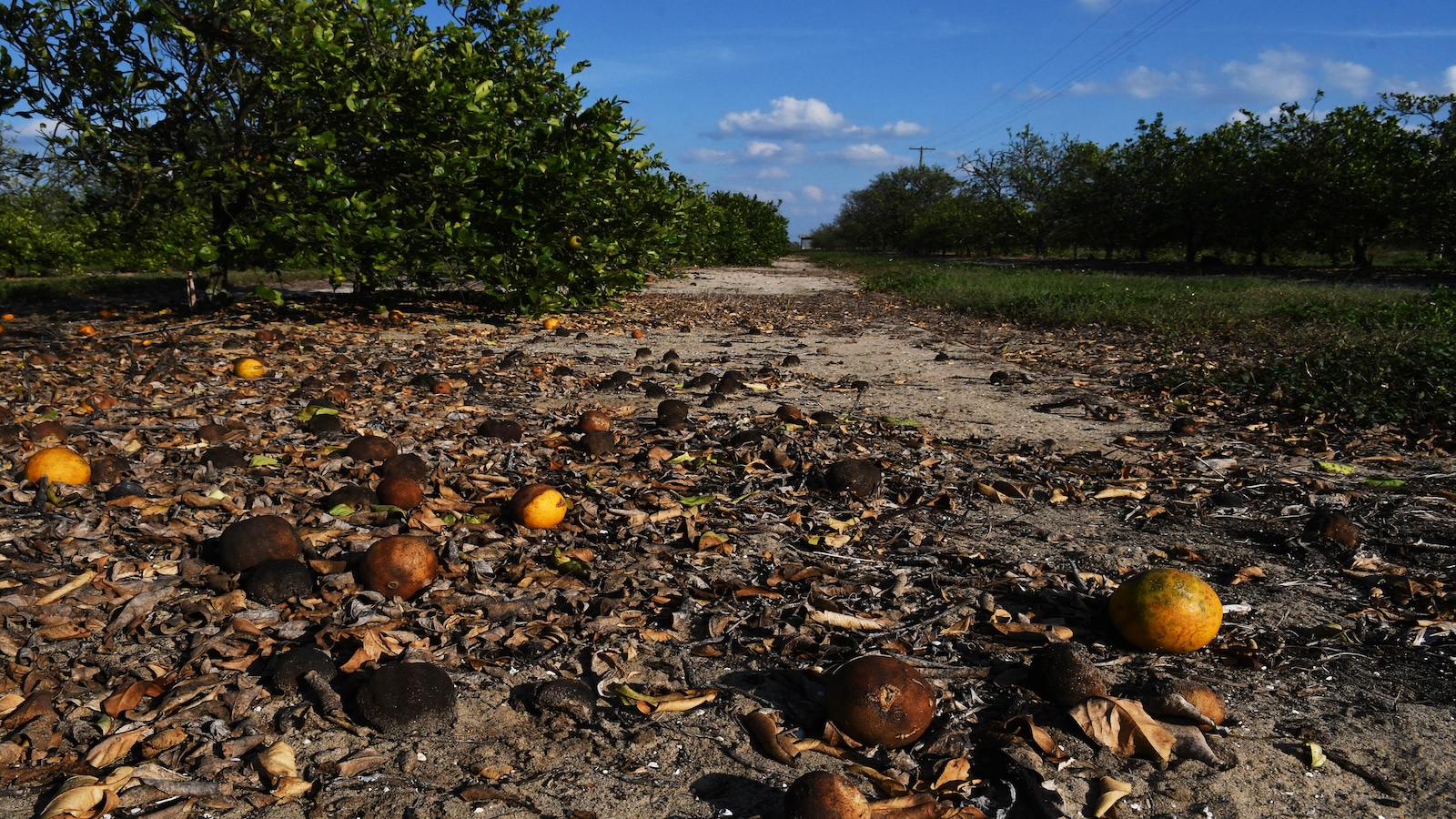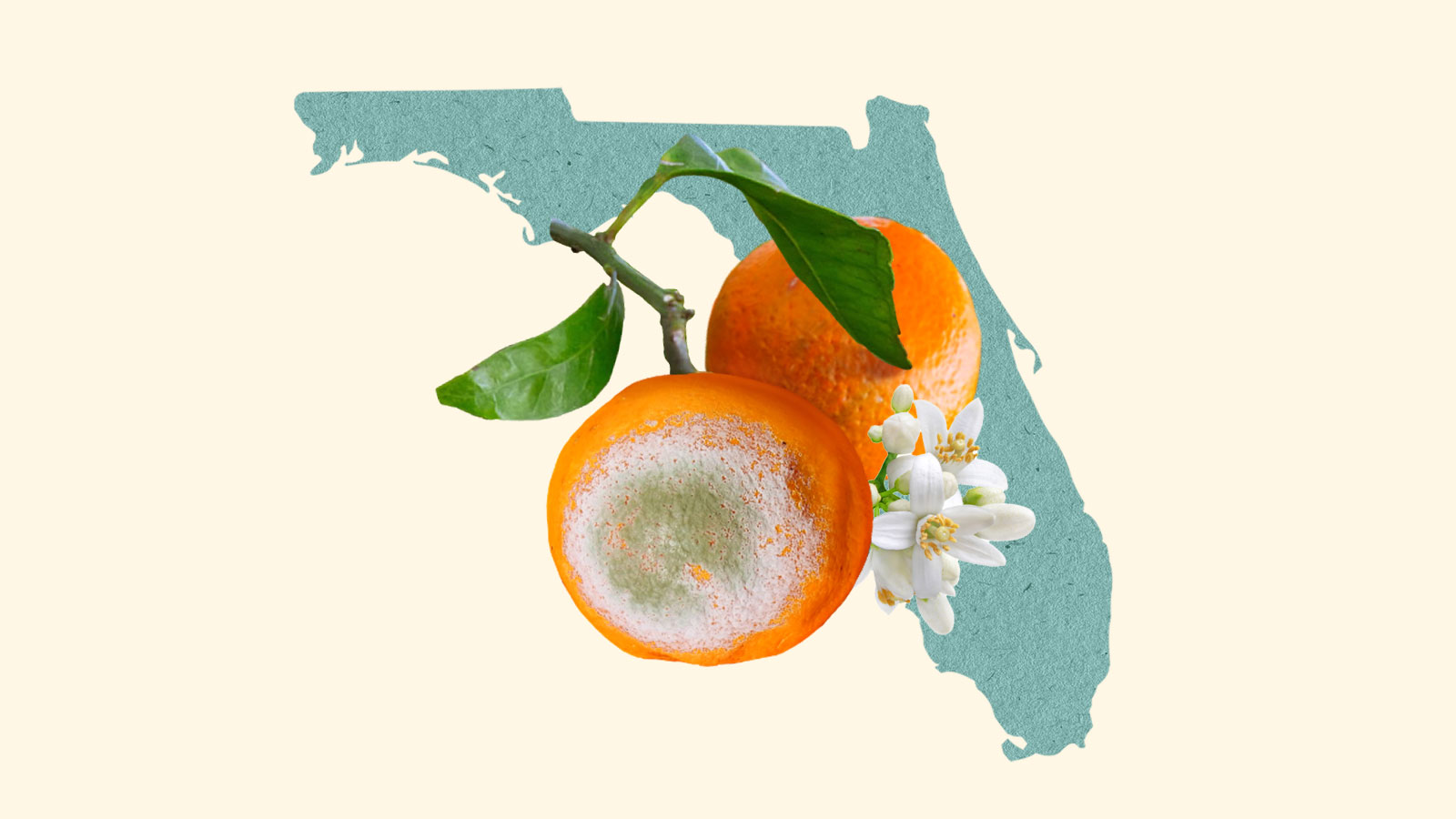Oranges are synonymous with Florida. The zesty fruit can be spotted adorning everything from license plates to kitschy memorabilia. Ask any Floridian and they’ll tell you that the crop is a hallmark of the Sunshine State.
Jay Clark would be quick to agree. He’s 80 and a third-generation grower working land his family has owned in Wauchula since the 1950s. But he’s not sure how much longer he can keep at it. Two years ago, Hurricane Ian pummeled trees already weakened by a virulent and incurable disease called citrus greening. It took more than a year to recover after the “whole crop was basically blown off” by 150 mph winds. “It’s a struggle,” said Clark. “I guess we’re too hard-headed just to quit totally, but it’s not a profitable business right now.”
His family once owned almost 500 acres in west central Florida, where they grew oranges and raised beef. They’ve sold much of that land in recent years, and have scaled back their citrus groves. “We’re concentrating more on the cattle,” he said. “Everybody’s looking for an alternative crop or solution.”
The state, which grows roughly 17 percent of the nation’s oranges, grapefruit, and other tangy fruit, produced just 18.1 million boxes during the 2022 to 2023 growing season, the smallest harvest in almost a century. That’s a 60 percent decrease from the season before, a decline driven largely by the compounding impacts of mysterious pathogens and hurricanes. This year, the USDA’s just-released final forecasts for the season reveal an 11.4 percent spike in production over last year, but that’s still not even half of what was produced during the 2021 to 2022 season.
Consumers across the country have felt the squeeze from these declines, which have been compounded by floods throttling harvests in Brazil, the world’s largest exporter of orange juice. All of this has pushed the cost of the beverage to record highs.
As climate change makes storms increasingly likely, diseases kill more trees, and water grows harder to come by, Florida’s nearly $7 billion citrus industry faces an existential threat. The Sunshine State, which was once among the world’s leading citrus producers and until 2014 produced almost three-quarters of the nation’s oranges, has weathered such challenges before. Its citrus growers are nothing if not resilient. Some have faith that ongoing research will find a cure for citrus greening, which would go a long way toward recovery. But others are less optimistic about the path ahead, as the dangers they face now are harbingers of the future.
“We’re still here, but it’s not a good situation. We’re here, but that’s about it,” said Clark. “It’s bigger than just our family as citrus growers. If a solution isn’t found, there will be no citrus industry.”

Citrus greening, an incurable disease spread by insects that ruins crops before eventually killing trees, has imperiled Florida’s citrus industry since the ailment took hold in a grove in Miami nearly two decades ago. It appeared a few years after an outbreak of citrus canker disease, which renders crops unsellable, and led to the loss of millions of trees statewide. Although greening has appeared in other citrus powerhouses like California and Texas, it hasn’t widely affected commercial groves in either state. The scope of the blight in Florida is by far the largest, and most costly — since 2005, it has cut production by 75 percent. The Sunshine State’s year-round subtropical climate allows the infestation to spread at a higher clip. But as warming continues to increase global temperatures, the disease is expected to advance northward.
“You see so many abandoned citrus groves on the highways, all of the roads,” said Amir Rezazadeh, of the University of Florida’s Institute of Food and Agricultural Sciences. “Most of those trees are just dead now.”
Rezazadeh acts as a liaison between university scientists scrambling to solve the problem and citrus growers in St. Lucie County, one of the state’s top producing areas. “We have so many meetings, visits with growers every month, and there are so many researchers working to develop resistant varieties,” he said. “And it’s just really making these citrus growers nervous. [Everyone] is waiting for the new research results.”
The greatest promise lies in antibiotics created to lessen the effects of greening. Despite encouraging early results at reducing symptoms, therapies like oxytetracycline are still in preliminary stages and require growers to inject the treatment into every infected tree. More importantly, it is not a cure, merely a stopgap — a way to keep afflicted trees alive while researchers race to figure out how to beat this mysterious disease.
“We need more time,” said Rezazadeh. Growers in St. Lucie County started using the antibiotic last year. “There are some hopes that we keep them alive until we find a cure.”
The state’s total citrus acreage suffered a massive blow in the 1990s when an eradication program for canker disease, then the industry’s biggest foe, resulted in the culling of hundreds of thousands of trees on private properties. In the years since citrus greening took hold, the ripple effects of the blight have compounded with an ever-present barrage of hurricanes, floods, and drought threatening growers.
Hurricanes do more than uproot trees, scatter fruit, and shake trees so violently it can take them years to recover. Torrential rain and flooding can inundate groves and deplete the soil of oxygen. Diseased trees face particular risk because illness often impacts their roots, weakening them. Ray Royce, executive director of Highlands County Citrus Growers Association, likens it to a pre-existing medical condition.
“I’m an old guy. I get a cold, or I get sick, it’s harder for me to recover at 66 than it was at 33. If I had some underlying health issues, it’s even harder,” he said. “Greening is kind of this negative underlying health condition that makes anything else that happens to the tree, that stresses that tree, just further magnified.”
It doesn’t help that climate change is bringing insufficient rainfall, higher temperatures, and record-setting dry seasons, leaving soils with less water. A lack of precipitation has also dried up wells and canals in some of the state’s most productive regions. All of this can reduce yields and cause fruit to drop prematurely.
Of course, healthy trees have a higher chance of withstanding such threats. But the tenacity of strong groves is being tested, and once-minor events like a short freeze can be enough to end any already on the verge of demise.
“We all of a sudden had a little bit of a run of bad luck. We had a hurricane. Then after the hurricane, we had a freeze,” said Royce. “Now we’ve just gone through a drought which will no doubt negatively impact the crop for next year. And so we, in a way, need to catch a couple of good breaks and have a few good years where we’re getting the right amount of moisture, where we don’t have hurricanes, or freezes, that are negatively impacting trees.”
Human-induced climate change means that the respite Royce desperately hopes for is improbable. In fact, forecasters expect this to be the most active hurricane season in recorded history. Researchers have also found that warming will increase the pressures of plant diseases, like greening, in crops worldwide.
Although “almost every tree in Florida” is afflicted with the disease, and the reality of warming temperatures spreading pathogens is a growing concern, the state’s citrus producing days are far from over, said Tim Widmer, a plant pathologist who specializes in crop diseases and plant health. “We don’t have the solution yet,” he said. “But there are things that look very, very promising.” A windfall of funding has been devoted to the hunt for answers to a befuddling problem. Florida’s legislature earmarked $65 million in the 2023-2024 budget to support the industry, while the 2018 federal farm bill included $25 million annually, for the length of the bill, toward combating the disease.
Widmer is a contractor at the U.S. Department of Agriculture’s Agricultural Research Service, which is devising an automated system (known as “symbiont technology”) that would “pump” therapies like antimicrobial peptides that destroy pathogens in a host tree, which allows growers to no longer have to manually administer injections. Think of it “kind of like a biofactory that produces the compounds of interest and delivers them directly into the tree,” said Widmer. But they’ve only just begun testing it in a 40-acre grove this spring. Other solutions scientists are pursuing include breeding new varieties of citrus that could be more blight-tolerant. “It takes anywhere from 8 to 10 to 12 years to develop a long-term solution for [greening], and also for some of the climate change factors that will impact citrus production,” said Widmer.
Time is something many family-owned operations can’t afford. In the last couple of years, a mounting number of Florida citrus groves, grower associations, and related businesses have closed for good. Ian was the breaking point for Sun Groves, a family business in Oldsmar that opened in 1933.
“We definitely suffered from freezes, hurricanes … and tried for as long as we could to stay in business in spite of all the challenges,” said Michelle Urbanski, who was the general manager. “When Hurricane Ian struck, that was really the final blow where we knew we had to close the business.”
The financial loss was too much, putting an end to the family’s almost century-long contribution to Florida’s enduring, now embattled, citrus legacy. “It was heartbreaking for my family to close Sun Groves,” she said. Amid a torrent of crippling infestations and calamitous storms, it’s a feeling many others may soon come to know.




